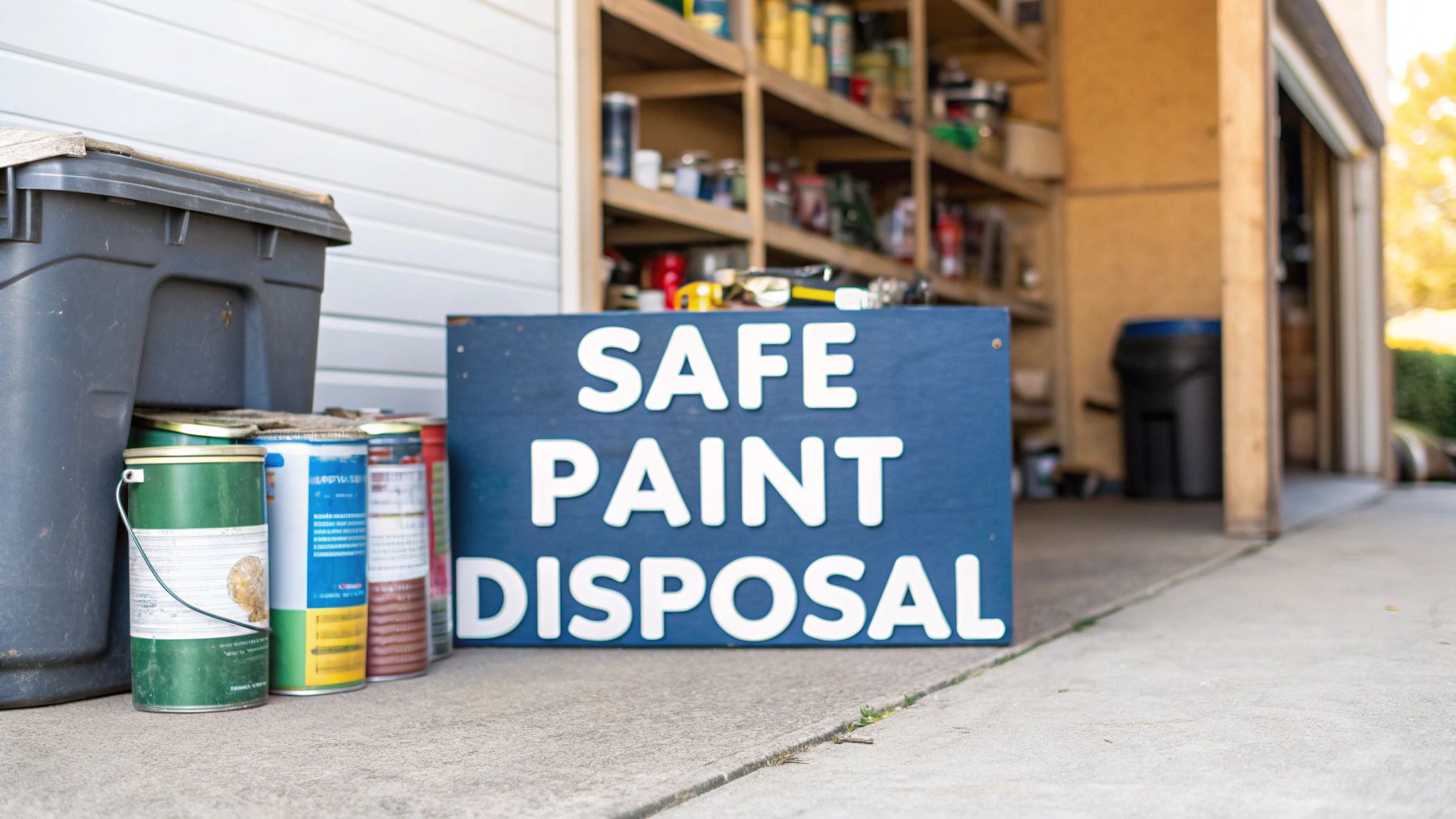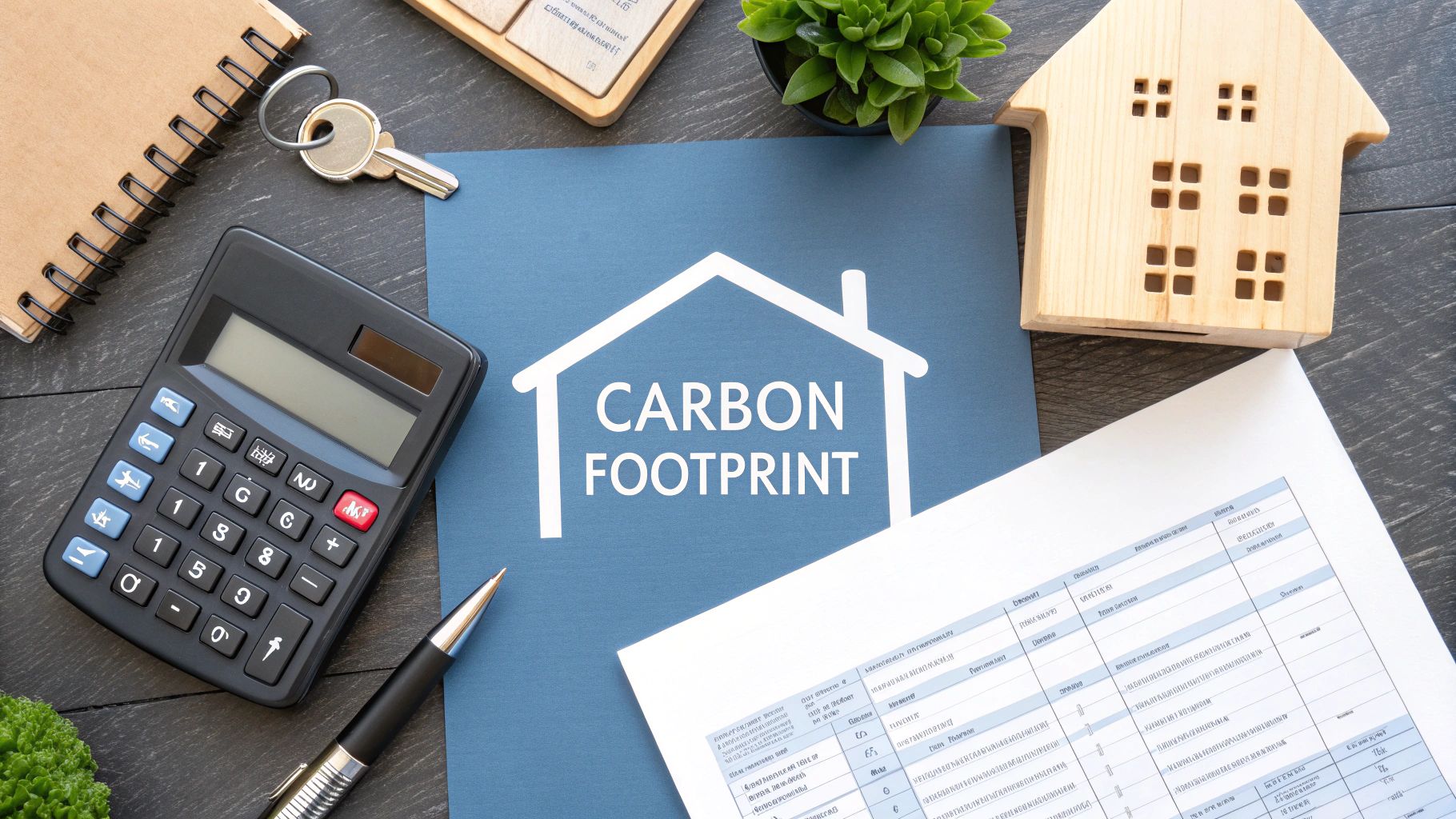How Do You Dispose of Broken Glass? Expert Safety Tips
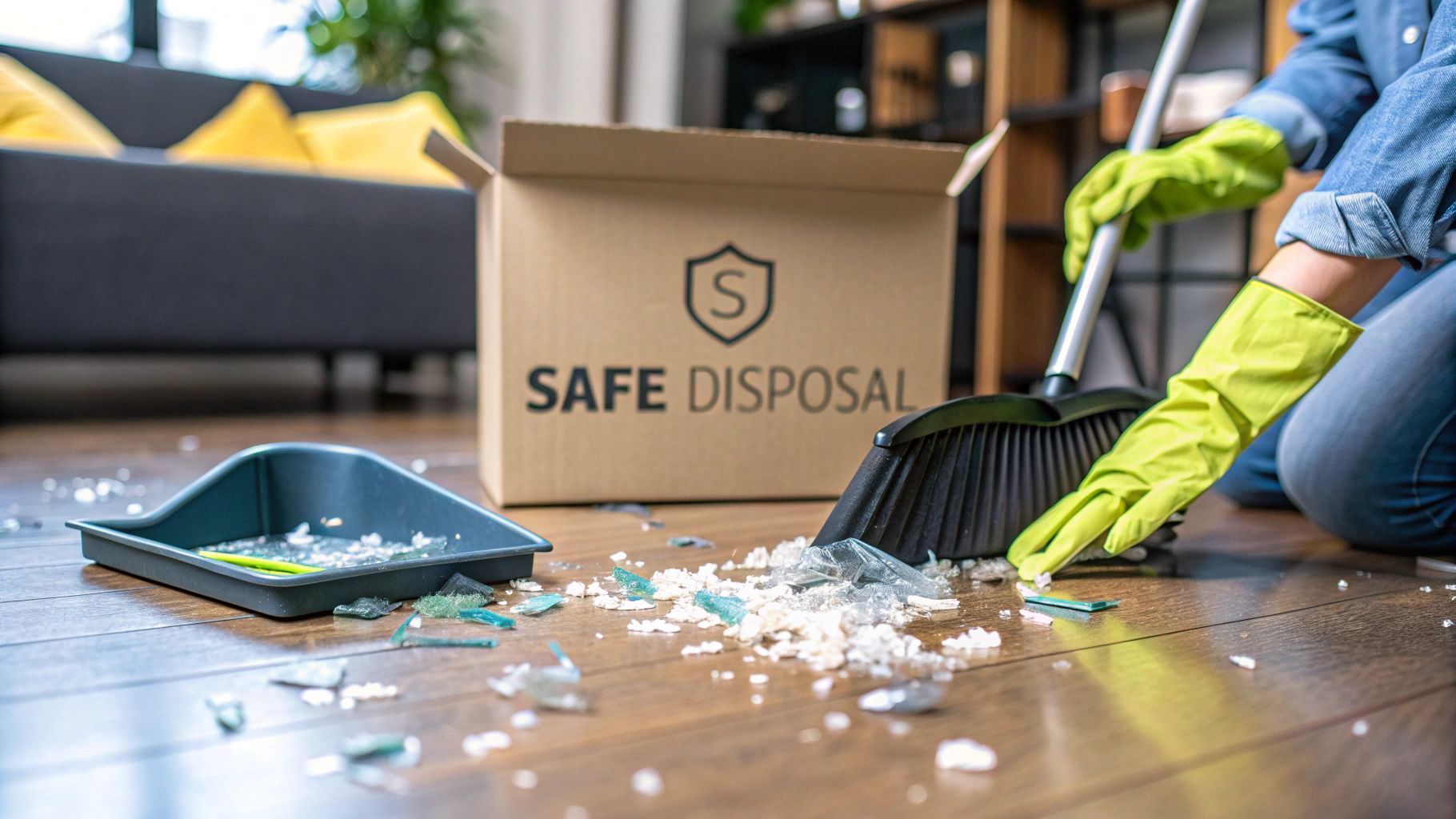
How Do You Dispose of Broken Glass? Expert Safety Tips
That dreaded sound of shattering glass. We’ve all been there. It’s a noise that makes you freeze for a second before the cleanup process kicks in. The most important thing is to take a breath and act calmly, making sure everyone is safe before you even think about grabbing a dustpan.
Your first move is always to secure the area. Then, it's all about gearing up with protective items like thick-soled shoes and heavy-duty gloves. Only then should you start sweeping up the big pieces, followed by a clever trick for the tiny, almost invisible slivers.
Your First Steps After Breaking Glass
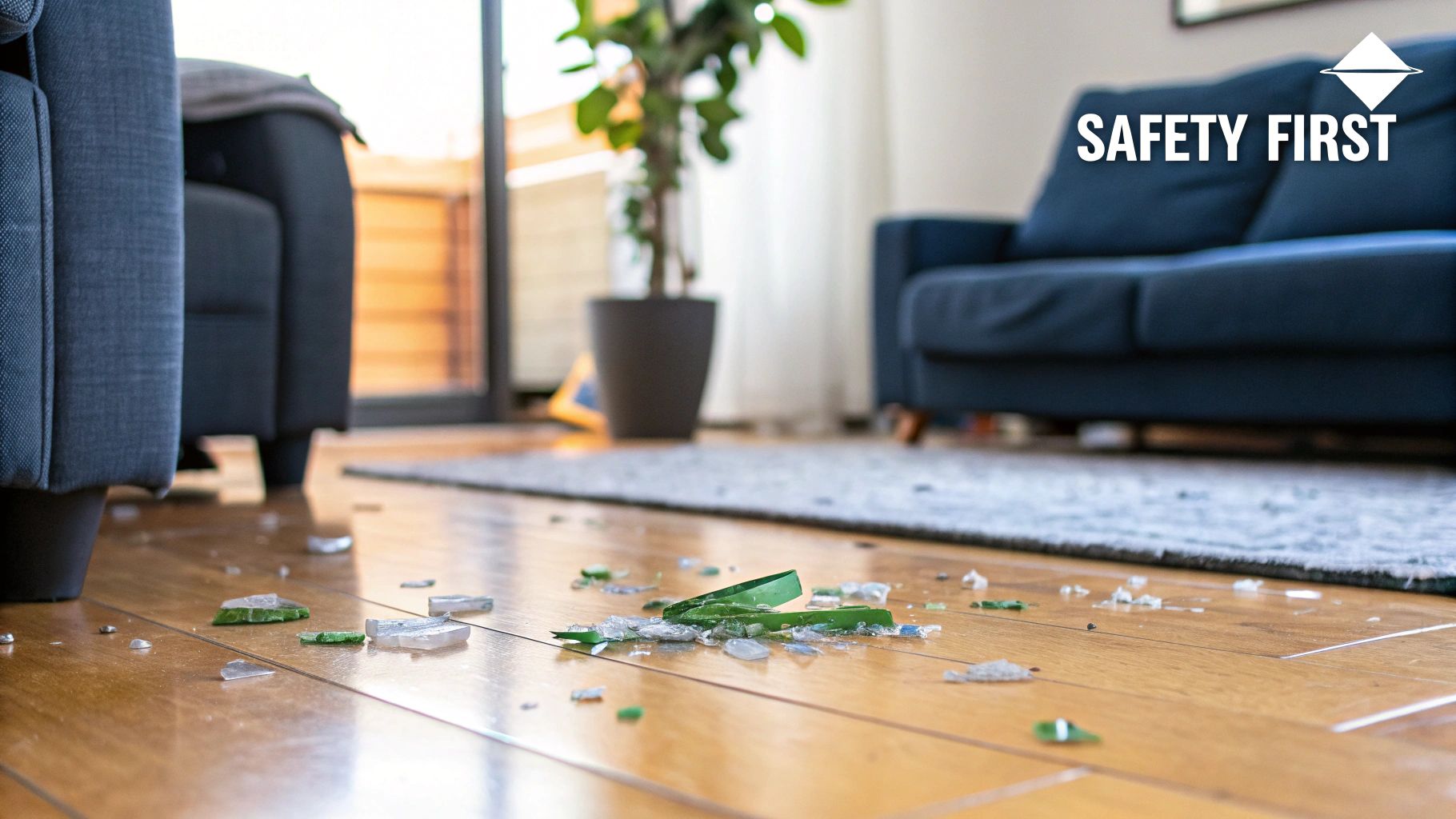
That heart-stopping crash often brings a wave of panic. But before you do anything, safety has to be your absolute number one priority. The immediate goal is simple: prevent anyone—especially kids or pets—from getting hurt.
Start by calmly telling everyone to stay well away from the area. If you've got pets, it’s a good idea to gently usher them into another room and shut the door. It’s a simple step, but it stops curious paws or little feet from wandering straight into a dangerous situation.
To make it even clearer, here's a quick checklist for those first few crucial moments.
Broken Glass Immediate Safety Checklist
| Action | Why It's Critical | Essential Tool |
|---|---|---|
| Secure the Area | Prevents anyone from walking on the glass and getting cut. | Your voice, clear instructions. |
| Move Pets & Kids | Keeps the most vulnerable family members out of harm's way. | A separate, closed-off room. |
| Put On Shoes | Protects your feet from unseen shards on the floor. | Thick-soled shoes or boots. |
| Wear Heavy Gloves | Prevents cuts to your hands during the cleanup process. | Gardening or work gloves. |
| Grab a Brush & Pan | The right tools for safely collecting the larger pieces. | A sturdy brush and dustpan. |
Following these five simple actions right away turns a chaotic moment into a controlled, safe situation, setting you up for a successful cleanup.
Gearing Up For A Safe Cleanup
Whatever you do, don't try to handle broken glass with bare hands or just in your socks. Even the tiniest shard can give you a surprisingly nasty cut. It's so important to grab the right protective gear before you even think about touching a single piece.
Your essential safety kit should include:
- Thick-soled shoes: A good pair of trainers or boots will create a solid barrier between your feet and any missed fragments.
- Heavy-duty gloves: Standard washing-up gloves are often too flimsy. Go for some thick gardening gloves or even leather work gloves to give yourself proper protection from sharp edges.
Once you’re kitted out, get your tools. A brush and dustpan are what you need for the bigger, obvious pieces of glass. A word of warning: resist the temptation to reach for the vacuum cleaner straight away. Fine glass dust and tiny shards can wreck the inside of many household models, and that’s a repair bill you don’t need. For a deeper dive into managing different household risks, our guide on the steps to safely manage hazardous waste in the UK has some really valuable insights.
Tackling The Tiniest Shards
The real danger often lies with the pieces you can't even see. After you've swept up the main fragments, you've got to deal with the microscopic slivers that are inevitably left behind. This is where a few old-school tricks really prove their worth.
A brilliant and surprisingly effective method is to gently press a slice of soft bread over the area. The spongy texture of the bread is perfect for picking up those fine glass particles that a brush just can't get.
A halved raw potato works just as well. Just press the cut side down onto the floor, and it'll grab any leftover bits. When you’re done, make sure you throw the bread or potato away with the rest of the glass. Sometimes, glass breakage is out of our control, like after a storm, and it helps to be prepared by understanding the impact of hail damage before you even start the cleanup.
How to Securely Package Broken Glass for Disposal
Okay, so you’ve swept up the last of the glittering dust. Now what? The next bit is just as important as the clean-up itself: getting that glass safely contained.
This isn’t just about being neat. It’s a crucial safety measure to protect everyone down the line, from your own family rummaging in the bin to the collection crews who handle our waste every day. A standard bin bag just won't cut it – those sharp edges will slice right through it, creating a nasty surprise for someone.
Your mission is to create a puncture-proof parcel. The good news? You almost certainly have what you need already lying around the house. No need for special bags.
Choosing the Right Container
A sturdy cardboard box is your best friend here. Think of that Amazon delivery box you haven’t got round to breaking down yet, or an old shoebox. Anything with thick, rigid walls that won’t tear easily is perfect.
Alternatively, a hard plastic container like an old ice cream tub or a large takeaway pot will do the trick nicely. Even a used coffee can is a brilliant option for smaller bits of glass. The goal is simple: find something solid enough that the shards can't poke their way out.
The one rule you absolutely must not break is this: never tip loose broken glass straight into a bin bag. It’s a huge risk to waste handlers. A proper, secure container is non-negotiable.
Once you’ve got your container sorted, it's time to pack it up properly. There’s a bit of an art to it, but it’s a simple method that keeps everything secure.
This infographic lays out the whole process, from putting on your gloves to the clever tricks for getting every last speck of dust.
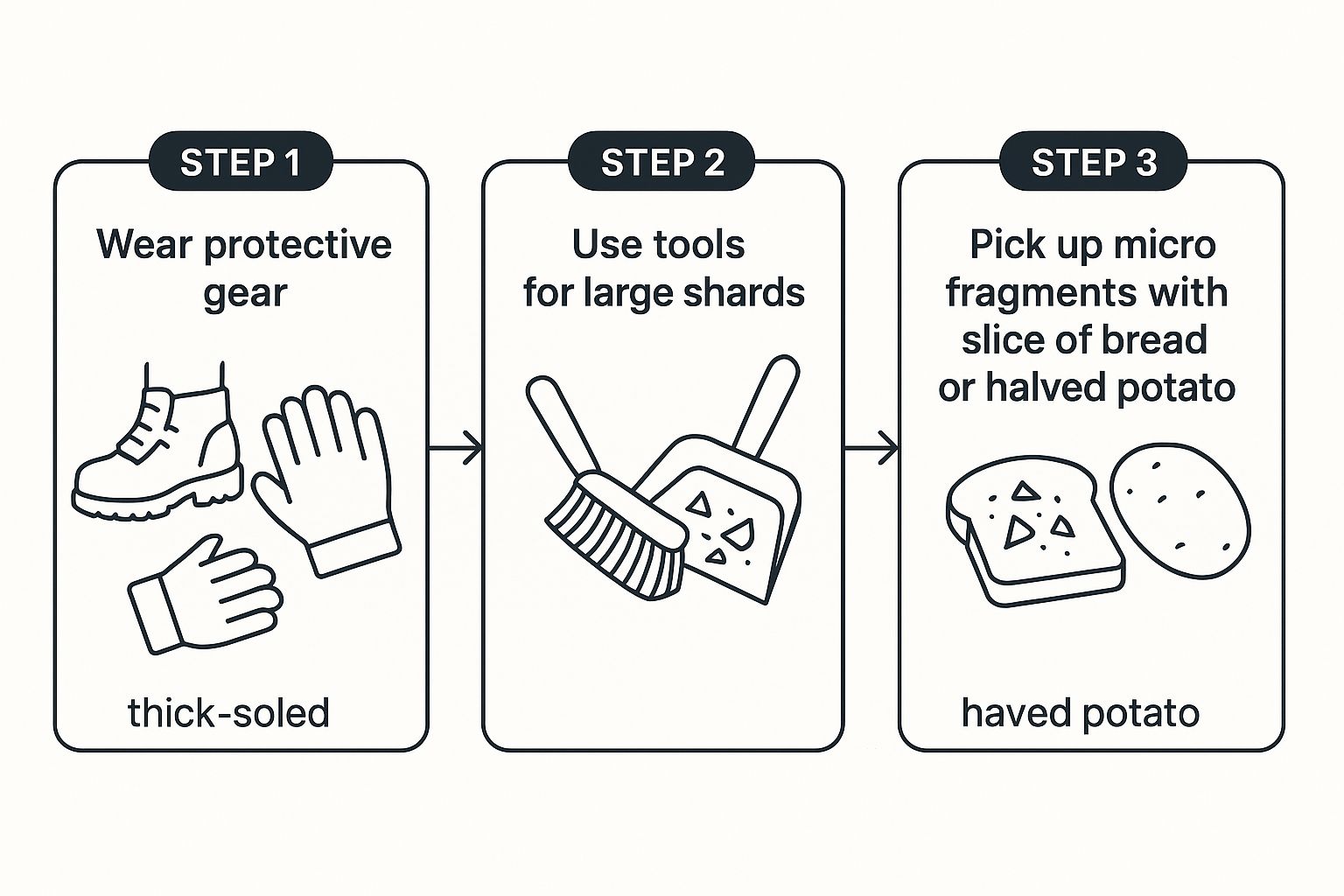
As you can see, protecting yourself and using the right kit is the foundation for a safe clean-up, long before you start thinking about the box.
The Correct Packing Method
First, line your chosen box or tub with a few sheets of old newspaper. This gives you an extra layer of protection and helps to cushion the glass.
Next, carefully place the bigger pieces of glass into the container, one by one. Try to avoid just tipping the contents of your dustpan straight in, as this can easily cause more breakage. Once the larger shards are in, you can add the smaller fragments and dust. A great tip here is to wrap these smaller bits in a few more layers of newspaper, creating a little bundle before you pop it in the box. This stops those tiny, razor-sharp slivers from moving about.
With all the glass safely inside:
- Stuff some crumpled newspaper or old kitchen roll on top to fill any gaps. This prevents the contents from rattling around.
- Seal the container securely with strong tape. Gaffer tape or proper packing tape is what you want. Go over all the seams to be sure.
- Finally – and this is vital – grab a thick permanent marker and label the container clearly. Write “BROKEN GLASS” in big, bold letters on every side. This simple action is a critical warning for anyone who handles it.
If you’re dealing with a bigger project that’s creating lots of different types of waste, it’s always worth checking what can go in a skip to make sure you’re getting everything right. With your glass now safely packaged and labelled, you’re ready for the final step: disposing of it according to your local council’s rules.
Understanding Your Local Council's Disposal Rules

So, you’ve got your broken glass all wrapped up, boxed, and labelled. Job done, right? Not quite. The final, crucial piece of the puzzle is figuring out what your local council actually wants you to do with it.
It’s easy to forget that in the UK, waste management isn’t a one-size-fits-all system. Every single council sets its own rules, and they can vary quite a bit from one area to the next.
These rules aren’t just red tape; they’re there for some very good, practical reasons. First and foremost, they’re designed to protect the waste collection crews who handle thousands of bins every single day. A stray shard of glass slicing through a bin bag can cause a nasty injury, and councils rightly want to prevent that.
There's also the machinery to think about. At the huge Material Recovery Facilities (MRFs) where our recycling gets sorted, loose glass is a real problem. It can jam up conveyor belts and, even worse, contaminate entire batches of other recyclables like paper and plastic, meaning it all has to be sent to landfill.
Finding Your Local Guidelines
Thankfully, finding out what your council requires is usually dead simple. Your first port of call should always be their official website.
Just hop onto a search engine and type in something like "[Your Town] council waste disposal" or "how to dispose of broken glass in [Your Borough]". This will almost certainly take you straight to the information you need.
You're looking for a section often called "Waste and Recycling" or "Bin Collections." Most councils have a handy A-Z guide telling you what can and can't go in your bins, which will give you the definitive answer.
The sheer amount of glass we use makes getting this right so important. The average UK household gets through around 500 glass bottles and jars every year. While we’re pretty good at recycling, a staggering 200,000 tonnes of glass still ends up in landfill annually. That figure includes broken glass, which is why following your local advice is a vital part of managing our waste properly. You can learn more about UK waste statistics and their impact by checking the latest government reports.
Common Disposal Routes
Once you’ve checked, you’ll find that your council will usually point you in one of two directions for your carefully packaged broken glass.
A word of warning: never just assume broken glass can go in your kerbside recycling bin. The sharp edges are a massive risk during the sorting process, both for people and machines, which is why most councils explicitly forbid it.
Your two most likely options will be:
- Your General Waste Bin: Most councils are happy for you to place safely boxed and clearly labelled broken glass in your general rubbish bin (the one that goes to landfill or incineration).
- Household Waste Recycling Centre (HWRC): The other common option is to take the box to your local tip. These sites have dedicated skips for different materials, and there's often one for either glass or general hardcore waste where it can be safely disposed of.
Taking a couple of minutes to check your council’s website is all it takes to make sure your broken glass is handled safely and responsibly the moment it leaves your home.
Can You Recycle Broken Glass in the UK?

When a glass shatters, it’s tempting to just sweep it up and tip it straight into the recycling bin with the rest of your bottles and jars. It seems like the right thing to do, but in nearly every case, it’s a mistake. The biggest issue here is safety – those sharp, unpredictable fragments are a real hazard for the people who manually sort our recycling.
That doesn't mean it’s destined for the bin, though. With a bit of know-how, you can make sure that broken glass is handled responsibly instead of just adding to landfill. It all comes down to understanding the difference between your kerbside collection and other options.
Why Kerbside Recycling Is Not the Answer
The sorting machinery at Material Recovery Facilities (MRFs) is a sophisticated piece of kit, but it’s designed to deal with whole containers, not tiny shards. Broken glass can wreak havoc on expensive equipment, contaminate other perfectly good recyclables like paper and card, and most importantly, cause serious injuries to the sorting staff.
This contamination problem is a huge deal. It can get so bad that entire lorry loads of recycling are rejected and diverted straight to landfill. You can read more about the knock-on effects in our guide to the environmental impact of landfills.
The UK is actually pretty good at recycling glass – we currently recycle around 75.2% of our glass packaging waste. But this whole system depends on getting clean, separated materials. Broken glass in kerbside bins just throws a spanner in the works. For anyone interested in the bigger picture, the British Glass roadmap to closed-loop recycling is a great read.
Because of these risks, almost every council in the UK has a strict 'no broken glass' policy for household recycling bins. This is exactly why knowing the right alternative is so important.
Your Best Bet: The Household Waste Recycling Centre
The safest, most reliable place for your carefully packaged broken glass is your local Household Waste Recycling Centre (HWRC) – or 'the tip', as most of us call it. These sites are properly equipped to handle all sorts of materials that can't go in your regular bins.
Finding your local centre is easy. Just search online for "[Your Town] HWRC" or "local tip" to get the address, opening hours, and any site-specific rules you might need to know, like whether you need to book a slot.
When you get there, you'll need to know which container to use. You’re usually looking for one of two things:
- Bottle Banks or Glass Recycling Skips: Most HWRCs have massive, dedicated skips just for glass. If you're not sure, the staff on site will point you in the right direction.
- Hardcore or Rubble Skips: Sometimes, you might be asked to put it in the skip for hardcore materials like bricks, ceramics, and rubble.
Taking this extra step makes a real difference. At the HWRC, the glass enters the right waste stream where it can be safely processed and put back to use. It might become new bottles, get mixed into aggregate for road construction, or even be used in water filtration systems. It’s a simple action that genuinely helps save energy and raw materials.
A Practical Guide to Different Glass Types
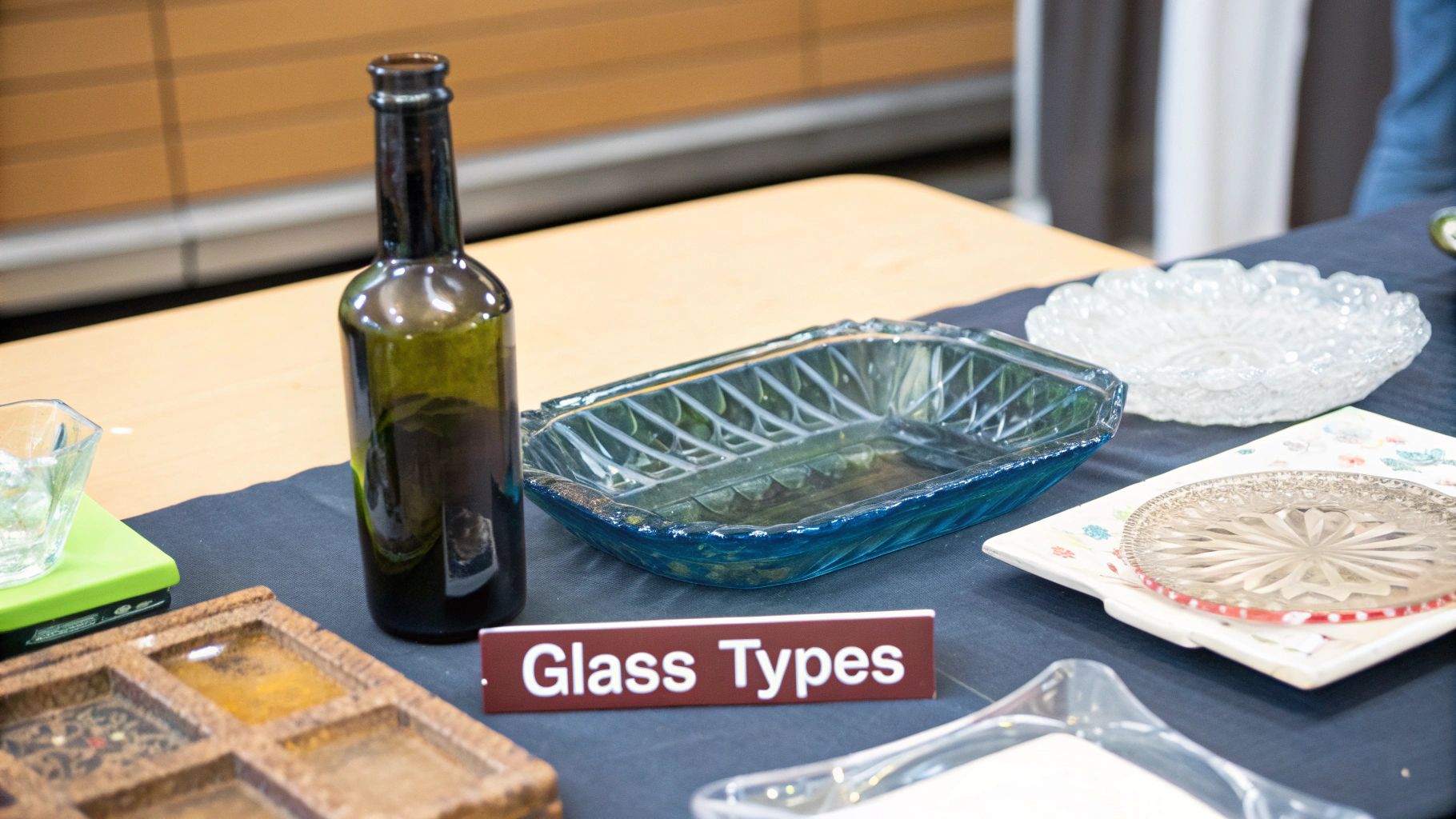
It’s a common mistake to think all glass is the same. The reality? When it comes to getting rid of it, the differences are massive. Knowing what you're dealing with is the first step to disposing of it safely and correctly.
The reason it all gets so complicated comes down to chemistry. Your average food jar or bottle is made from soda-lime glass, which has a specific, low melting point perfect for recycling. But other types of glass—like your kitchen tumblers or oven dishes—are treated with chemicals or heat to make them tougher.
Mixing these different glass types can contaminate an entire batch at the recycling plant. It’s the classic red-sock-in-a-white-wash scenario; one wrong item can ruin the whole lot.
Disposal Methods for Common Household Glass
To make things clearer, let's break down the common types of glass you'll find around the house and where they need to go. This table gives you a quick at-a-glance guide.
| Type of Glass | Recycle with Bottles? | Correct Disposal Method |
|---|---|---|
| Food Jars & Drink Bottles | Yes | Place in your bottle bank or recycling bin. Remove lids first. |
| Drinking Glasses & Tumblers | No | Wrap securely and place in your general household waste bin. |
| Pyrex & Glass Cookware | No | Wrap securely and place in your general household waste bin. |
| Mirrors | No | Wrap securely and place in your general household waste bin. |
| Window Panes | No | Take to your local HWRC; may have a separate skip for rubble. |
| Light Bulbs (Incandescent) | No | Wrap securely and place in your general household waste bin. |
| Light Bulbs (LED/CFL) | No | Take to a dedicated collection point at your HWRC as hazardous waste. |
As you can see, most household glass actually belongs in the general waste. Only standard bottles and jars are destined for the recycling bin.
Everyday Bottles and Jars
Let's start with the easy stuff. The glass from jam jars, wine bottles, and pasta sauce containers is the most straightforward to recycle. Once you've safely packaged up any broken pieces, they can usually go straight into the glass recycling skip at your local Household Waste Recycling Centre (HWRC).
These are the gold standard for recycling because their chemical makeup is so consistent. Just remember one crucial thing: always remove the metal lids. They get recycled separately and can cause big problems if left on.
Toughened Glassware and Cookware
Now for the tricky part. That drinking glass that just smashed on the floor? Or the Pyrex dish that finally gave up the ghost? These absolutely cannot go into your bottle recycling.
These items are made from toughened or borosilicate glass, manufactured with special treatments to make them durable and resistant to heat shock.
- Drinking Glasses: Often contain chemicals that strengthen them but also change their melting point.
- Pyrex or Glass Cookware: Made to withstand extreme oven temperatures, meaning they won’t melt down correctly with standard bottles.
- Mirrors: The reflective coating on the back is a major contaminant in the glass recycling process.
Because of how they're made, these glass types have to be carefully wrapped and put in your general waste bin. Never, ever mix them with your recyclable bottles.
Window Panes and Car Glass
Window glass (also called float glass) is another category entirely. It has a different chemical structure to container glass, so it can't be recycled with it. If you've had work done on your car, it's worth knowing that disposing of the old glass from professional auto glass replacement services is a specialised task.
For household window panes, your local HWRC might have a separate container, often in the 'hardcore' or 'rubble' section. It's always best to check your local council's rules first before you make the trip.
And what about light bulbs? Old-style incandescent bulbs have metal filaments and can't be recycled with glass, so they go in the general waste. Newer energy-saving bulbs and fluorescent tubes are classed as hazardous waste and need to be taken to a dedicated collection point at your local tip. Getting this right ensures every bit of broken glass is handled safely.
Got a Question About Disposing of Broken Glass?
Even when you follow the steps perfectly, you can still be left scratching your head over a few tricky details. Let's run through some of the most common questions we get asked, so you can handle any situation like a pro.
What About That Invisible Glass Dust?
You've swept, you've dabbed with a damp paper towel… but have you really got all of it? It’s a common worry, especially with kids or pets around.
For that extra peace of mind, grab a microfibre cloth. Lightly dampen it and give the entire area a final wipe-down. The unique weave of a microfibre cloth is an absolute magnet for those tiny, near-invisible specks that other methods can leave behind.
Is a Simple Plastic Bag Ever Good Enough?
Honestly? No, not really. A sturdy box is always your safest bet. But we get it – sometimes you’re caught out and have to make do.
If you absolutely must use a bag, think layers. First, wrap the glass shards thoroughly in heaps of newspaper or an old rag. Place this bundle into the centre of several thick plastic bags, one inside the other. It's a stopgap solution at best, and you absolutely must label it clearly.
How Do I Handle a Smashed Car Window?
This is a big one. Car glass isn't your average household glass; it's either toughened or laminated for safety. This means it can’t just be tossed in with your bottle recycling.
Package it up securely in a puncture-proof box, just like any other broken glass, and label it. Your options are then to either put it in your general waste or, better yet, take it to your local Household Waste Recycling Centre (HWRC). They'll usually direct you to the 'hardcore' or 'rubble' skip.
What’s the Deal With Broken Mirrors?
A broken mirror is more than just bad luck – it's a real problem for recyclers. That reflective coating on the back will contaminate an entire batch of recycled glass.
Treat a broken mirror exactly as you would a broken pint glass. Wrap the sharp pieces carefully in newspaper, pop them into a sealed, sturdy cardboard box, and label it loud and clear: "DANGER: BROKEN MIRROR GLASS". This goes into your general waste bin, never recycling.
Do I Take the Metal Lid Off a Smashed Jar?
Yes, always. While plastic caps can sometimes be a grey area, metal lids are different. Magnets are used at the sorting facility to pull out metals for recycling.
If you can safely retrieve the lid from the broken jar, give it a quick rinse and put it in your recycling bin separately. Leaving it attached to the broken glass just causes contamination issues down the line.
From a simple garden clear-out to a major renovation project, The Waste Group offers reliable, professional skip hire and disposal services across Dorset. Find out more at https://www.thewastegroup.co.uk.
